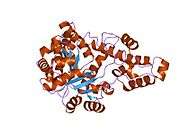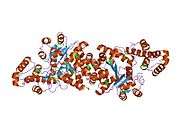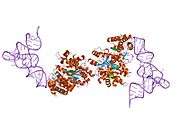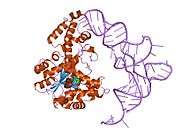WARS (gene)
| WARS
|
|---|
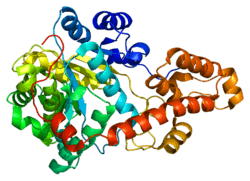 |
| Available structures |
|---|
| PDB | Ortholog search: PDBe RCSB |
|---|
| List of PDB id codes |
|
1O5T, 1R6T, 1R6U, 1ULH, 2AKE, 2AZX, 2DR2, 2QUH, 2QUI, 2QUJ, 2QUK
| | |
| Identifiers |
|---|
| Aliases |
WARS, Tryptophanyl-tRNA synthetase, cytoplasmic, GAMMA-2, IFI53, IFP53, tryptophanyl-tRNA synthetase |
|---|
| External IDs |
MGI: 104630 HomoloGene: 3084 GeneCards: WARS
|
|---|
|
|
| RNA expression pattern |
|---|
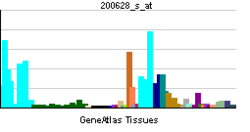
 |
| More reference expression data
|
| Orthologs |
|---|
| Species |
Human |
Mouse |
|---|
| Entrez |
|
|
|---|
| Ensembl |
|
|
|---|
| UniProt |
|
|
|---|
| RefSeq (mRNA) |
| |
|---|
| RefSeq (protein) |
| |
|---|
| Location (UCSC) |
Chr 14: 100.33 – 100.38 Mb |
Chr 12: 108.86 – 108.89 Mb |
|---|
| PubMed search |
[1] |
[2]
|
|---|
| Wikidata |
Tryptophanyl-tRNA synthetase, cytoplasmic is an enzyme that in humans is encoded by the WARS gene.[3][4][5]
Aminoacyl-tRNA synthetases catalyze the aminoacylation of tRNA by their cognate amino acid. Because of their central role in linking amino acids with nucleotide triplets contained in tRNAs, aminoacyl-tRNA synthetases are thought to be among the first proteins that appeared in evolution. Two forms of tryptophanyl-tRNA synthetase exist, a cytoplasmic form, named WARS, and a mitochondrial form, named WARS2. Tryptophanyl-tRNA synthetase (WARS) catalyzes the aminoacylation of tRNA(trp) with tryptophan and is induced by interferon. Tryptophanyl-tRNA synthetase belongs to the class I tRNA synthetase family. Four transcript variants encoding two different isoforms have been found for this gene.[5]
References
Further reading
- Ewalt KL, Schimmel P (2002). "Activation of angiogenic signaling pathways by two human tRNA synthetases.". Biochemistry. 41 (45): 13344–9. doi:10.1021/bi020537k. PMID 12416978.
- Rasmussen HH, van Damme J, Puype M, et al. (1993). "Microsequences of 145 proteins recorded in the two-dimensional gel protein database of normal human epidermal keratinocytes.". Electrophoresis. 13 (12): 960–9. doi:10.1002/elps.11501301199. PMID 1286667.
- Bange FC, Flohr T, Buwitt U, Böttger EC (1992). "An interferon-induced protein with release factor activity is a tryptophanyl-tRNA synthetase.". FEBS Lett. 300 (2): 162–6. doi:10.1016/0014-5793(92)80187-L. PMID 1373391.
- Rubin BY, Anderson SL, Xing L, et al. (1992). "Interferon induces tryptophanyl-tRNA synthetase expression in human fibroblasts.". J. Biol. Chem. 266 (36): 24245–8. PMID 1761529.
- Frolova LYu, Sudomoina MA, Grigorieva AYu, et al. (1992). "Cloning and nucleotide sequence of the structural gene encoding for human tryptophanyl-tRNA synthetase.". Gene. 109 (2): 291–6. doi:10.1016/0378-1119(91)90624-K. PMID 1765274.
- Frolova LY, Grigorieva AY, Sudomoina MA, Kisselev LL (1993). "The human gene encoding tryptophanyl-tRNA synthetase: interferon-response elements and exon-intron organization.". Gene. 128 (2): 237–45. doi:10.1016/0378-1119(93)90568-N. PMID 7685728.
- Popenko VI, Cherny NE, Beresten SF, et al. (1994). "Immunoelectron microscopic location of tryptophanyl-tRNA synthetase in mammalian, prokaryotic and archaebacterial cells.". Eur. J. Cell Biol. 62 (2): 248–58. PMID 7925483.
- Børglum AD, Flint T, Tommerup N, et al. (1996). "Assignment of the human tryptophanyl-tRNA synthetase gene (WARS) to chromosome 14q32.2 --> q32.32.". Cytogenet. Cell Genet. 73 (1-2): 99–103. doi:10.1159/000134317. PMID 8646895.
- Sokolova IV, Narovlianskiĭ AN, Amchenkova AM, Turpaev KT (1996). "[Alternative splicing of 5'-terminal exons of the human tryptophanyl-tRNA synthetase gene]". Mol. Biol. (Mosk.). 30 (2): 319–29. PMID 8724762.
- Krause SW, Rehli M, Kreutz M, et al. (1996). "Differential screening identifies genetic markers of monocyte to macrophage maturation.". J. Leukoc. Biol. 60 (4): 540–5. PMID 8864140.
- Yuan W, Collado-Hidalgo A, Yufit T, et al. (1998). "Modulation of cellular tryptophan metabolism in human fibroblasts by transforming growth factor-beta: selective inhibition of indoleamine 2,3-dioxygenase and tryptophanyl-tRNA synthetase gene expression.". J. Cell. Physiol. 177 (1): 174–86. doi:10.1002/(SICI)1097-4652(199810)177:1<174::AID-JCP18>3.0.CO;2-D. PMID 9731757.
- Jensen LL, Nielsen MM, Justesen J, Hansen LL (2001). "Assignment of human NADH dehydrogenase (ubiquinone) 1 beta subcomplex 3 (NDUFB3) and of its four pseudogenes to human chromosomes 2q31.3, 1p13.3→p13.1, 9q32→q34.1, 14q22.3→q23.1 and 14q32.2 by radiation hybrid mapping.". Cytogenet. Cell Genet. 93 (1-2): 147–50. doi:10.1159/000056973. PMID 11474204.
- Otani A, Slike BM, Dorrell MI, et al. (2002). "A fragment of human TrpRS as a potent antagonist of ocular angiogenesis.". Proc. Natl. Acad. Sci. U.S.A. 99 (1): 178–83. doi:10.1073/pnas.012601899. PMC 117535
 . PMID 11773625.
. PMID 11773625.
- Wakasugi K, Slike BM, Hood J, et al. (2002). "A human aminoacyl-tRNA synthetase as a regulator of angiogenesis.". Proc. Natl. Acad. Sci. U.S.A. 99 (1): 173–7. doi:10.1073/pnas.012602099. PMC 117534
 . PMID 11773626.
. PMID 11773626.
- Sang Lee J, Gyu Park S, Park H, et al. (2002). "Interaction network of human aminoacyl-tRNA synthetases and subunits of elongation factor 1 complex.". Biochem. Biophys. Res. Commun. 291 (1): 158–64. doi:10.1006/bbrc.2002.6398. PMID 11829477.
- Guo Q, Gong Q, Tong KL, et al. (2002). "Recognition by tryptophanyl-tRNA synthetases of discriminator base on tRNATrp from three biological domains.". J. Biol. Chem. 277 (16): 14343–9. doi:10.1074/jbc.M111745200. PMID 11834741.
- Strausberg RL, Feingold EA, Grouse LH, et al. (2003). "Generation and initial analysis of more than 15,000 full-length human and mouse cDNA sequences.". Proc. Natl. Acad. Sci. U.S.A. 99 (26): 16899–903. doi:10.1073/pnas.242603899. PMC 139241
 . PMID 12477932.
. PMID 12477932.
PDB gallery |
|---|
|
| 1o5t: Crystal structure of the aminoacylation catalytic fragment of human tryptophanyl-tRNA synthetase |
| 1r6t: crystal structure of human tryptophanyl-tRNA synthetase |
| 1r6u: Crystal structure of an active fragment of human tryptophanyl-tRNA synthetase with cytokine activity |
| 1ulh: A short peptide insertion crucial for angiostatic activity of human tryptophanyl-tRNA synthetase |
| 2ake: Structure of human tryptophanyl-tRNA synthetase in complex with tRNA(Trp) |
| 2azx: Charged and uncharged tRNAs adopt distinct conformations when complexed with human tryptophanyl-tRNA synthetase |
| 2dr2: Structure of human tryptophanyl-tRNA synthetase in complex with tRNA(Trp) |
|
|



 . PMID 1537332.
. PMID 1537332. . PMID 1763065.
. PMID 1763065. . PMID 11773625.
. PMID 11773625. . PMID 11773626.
. PMID 11773626. . PMID 12477932.
. PMID 12477932.